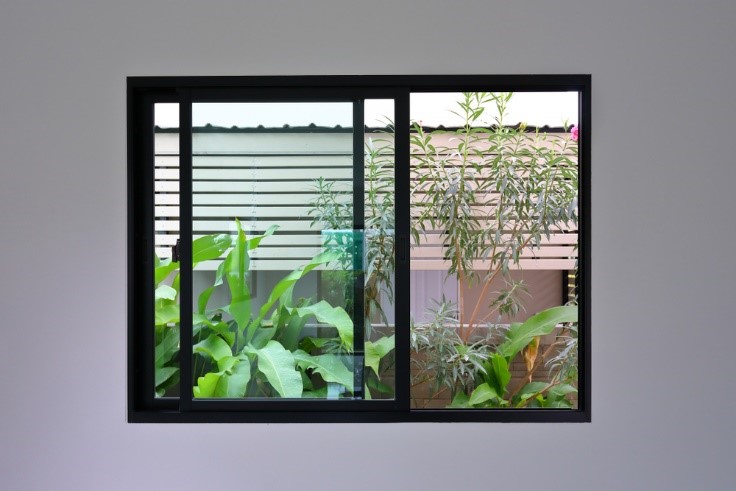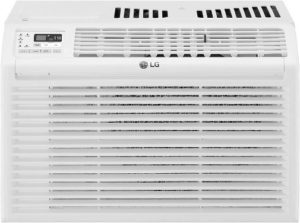
Most window air conditioning units are designed to sit in vertically opening windows. Those specially designed to fit into sliding windows cost more than the regular window air conditioners so created a guide for you to learn how to install a window air conditioner in a sliding window.
Since window conditioners are mounted temporarily during the summer months, most people prefer to use the standard ones, even in sliding windows. If that’s the case, you’ll want to make a custom frame to install them in horizontal sliding windows.
This article provides a step-by-step process for installing a sliding window air conditioner in a horizontal sliding window. We recommend having intermediate handyman skills — you can do it alone or enlist the help of a friend or spouse.
Steps to Install a Window Air Conditioner in a Sliding Window

What You Need
- A window air conditioner
- Plexiglass or plywood
- Weatherstripping
- Power drill
- Measuring tape
- Scissors
- Screws
- Flathead and Philips screwdriver
- Table saw
Choose an Installation Location
The best installation location for your window unit is near a wall-mounted power source compatible with your AC unit. While you could use an extension cord for the power supply, it may not provide enough power for the specific model of window air conditioner you purchased.
We also recommend inspecting the window sill to ensure it is not damaged or broken. You need a sturdy surface to mount the custom-built window frame and the air conditioning unit.
Take the Window Air Conditioner’s Measurements
Start by removing the side panels of the AC unit. Usually, they are attached to the unit using screws. Use a screwdriver to loosen and remove them.
Next, take the unit’s measurements. Measure the width, including any protruding parts such as vents. Measure the height, excluding the lips on the bottom and the top rail. Jot down the dimensions.
Take Measurements for the Frame
Measure the width and thickness of the sill and jot the measurements down. Then measure the height of the window frame from the bottom corner to the top corner. Subtract the height of the air conditioner from the height of the window sill to get the right height dimensions for the frame.
Construct the Custom Frame
You need lumber that is as thick and wide as the windowsill. Take two long pieces of wood and cut them to the size of the windowsill’s height using a table saw. Then, take two shorter lumber pieces and mark the width of the air conditioner. Cut the lumber pieces accordingly using a table saw.
From the bottom side of the long lumber pieces, mark the height of the window air conditioner. Join the lumber pieces. Join one of the short lumbers on the uppermost side of the longer lumber pieces.
Then join the other short lumber at the points where you marked the height of the air conditioner. Make sure the corners are square, and the joints are firm. Once done, fit the frame onto the window to ensure it is a good fit.
If you don’t have the time, patience, or skills to construct your own frame for your window air conditioner unit, you can find a window kit and installation kit online that you can use instead for installing a room air conditioner in your sliding windows.
Install the Frame and the AC Unit
If you use the correct width and thickness of the lumber, the frame should fit snuggly onto the windowsill of your slider window. Nevertheless, you may need to reinforce the attachment of the frame on the sill with nails or screws. It should fit such that when you close the sliding window, the outer sill of the window fits on the outer edge of the frame.
Then install the window air conditioner. With the help of a partner, lift the air conditioner into place and plant its bottom onto the windowsill so that the channels at the bottom align with the sill.
Slide the air conditioner forward until the bottom of the lower frame is in touch with the bottom of the top rail. The inner edge of the top rail should be on the outside of the bottom of the frame. That way, the frame prevents the window air conditioner from leaning forward further.
Screw Plywood or Plexiglass Onto the Frame
If you want to allow as much natural light into the house as possible after your AC installation, screw plexiglass onto the wooden frame. Otherwise, use plywood. Mark the dimensions of the frame on the plywood or plexiglass and cut it accordingly.
Install Weatherstripping
Install weatherstripping all around the air conditioner unit once it is secured in place. Make sure you use weatherstripping in the space between the top rail and the bottom of the frame, on the sides, and between the windowpane and the bottom of the air conditioners. Depending on how tight the spaces are, you may need to squeeze the weatherstripping into place.
Tips for Ensuring You Install a Window Air Conditioner Properly In a Sliding Window
Decide If You Want to Tilt the Air Conditioner
It depends on the model of the air conditioner. Some manufacturers specify that you need to tilt the unit by ¼ – ½ inch on the outside to allow condensation water to pour outside rather than inside your home.
Some of those that do not require tilting usually have a drip pan fitted on the inside to collect water. Others have built-in gutters that ensure they drain effectively without needing to tilt them.
Weight Distribution
Once you place the bottom of the air conditioner on the windowsill, ensure the unit’s weight is evenly distributed. Pay close attention to the weight distribution if the unit requires tilting.
You may need to support the bottom of the air conditioner from the outside to prevent it from being too overbearing on the windowsill. You can install brackets on the outside or place a piece of would underneath the unit on the outside.
Install the Correct Size
 For the window air conditioner to be efficient and effective, it has to have the right capacity. Generally, you need 20 BTUs to cool a square foot of space. For example, the LG 6,000 BTU window air conditioner is sufficient and has the cooling capacity for a 250 square foot room.
For the window air conditioner to be efficient and effective, it has to have the right capacity. Generally, you need 20 BTUs to cool a square foot of space. For example, the LG 6,000 BTU window air conditioner is sufficient and has the cooling capacity for a 250 square foot room.
However, it may require a higher capacity if the room has high ceilings, receives direct sunlight, or the temperatures are extremely high.
Conversely, an extremely large unit will not cool a smaller room better. It will only increase your energy bills without any considerable benefit. Rather, a smaller unit that befits the size of the room and the weather conditions will be more efficient if left to operate for longer.
Enlist Help When Installing the Air Conditioner
Most window air conditioners weigh between 50 and 100 pounds. This can be quite heavy to lift on your own. If the unit outweighs your ability to lift it, it can drop accidentally and hurt your feet or legs. It could also get damaged.
Bottom Line
Window air conditioners are an efficient and affordable method of keeping space cool. They work best if you are only keen to cool specific spaces, e.g., a given room in your house, an office, the attic, etc. Keep in mind if you live in a rented property, you may need to seek permission from the landlord before installing a window air conditioner.
Learning how to install a window air conditioner in a sliding window does not have to be a complicated process. However, you need at least intermediate skills to be able to construct the custom frame needed to keep it in place and cover gaps.
When installing your AC unit, make sure it is a sturdy and stable fit and weatherstrip the sides for insulation purposes. Check your AC unit’s manual for installation instructions that are more specific to the particular model you have chosen.
Now that we are getting into cooler weather, you might also want to consider purchasing a good space heater. Learn more about how space heaters work and what to look for when trying to find the best.
